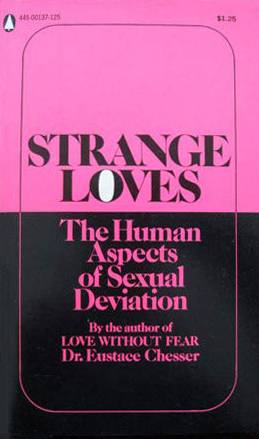Strange Loves
The Human Aspects of Sexual Deviation
Eustace Chesser
And so one decade cross?dissolves into the next, and the next, and suddenly here I am, poring over another book by Dr. Chesser, only now I am 35 and married and the reason I am poring over “Strange Loves” is not to memorize it but to review it. I see Dr. Chesser has not been idle. “Strange Loves” is his 29th book. I’ve just hunted down my old paperback copy of “Love Without Fear,” found its pages browned by the slow burn of age, the special four?page section crumbling away a bit worse than the rest, and all of a sudden I notice something that I’ve never really noticed in all the times I’ve looked at it: Dr. Chesser has gone and labeled the missionary position the “Normal Position.” I don’t mean to suggest the good doctor truly felt that the other 10 he described were abnormal positions. Still, one wonders: Could the appellation have been entirely devoid of editorial comment?
Well, what the hell. Over 20 years and three and a half million copies have passed since he first wrote that book, and an awful lot has happened since, what with the Sexual Revolution, Masters and Johnson, Dr. David Reuben, “The Sensuous Woman” and all. So it’s not surprising to find Dr. Chesser in his new book speaking of a wide range of sexual deviations with something less than censure. He investigates fetishism, transvestism and trans?sexualism, homosexuality and lesbianism, voyeurism and exhibitionism, sadism and masochism, nymphomania and satyriasis, and the tone throughout is commonsense and gentle.
He also lets us in on some fairly interesting little tidbits along the way. Like: “The philosopher Descartes was fascinated all his life by women with a squint.” And like: Dr. Desmond Morris, author of “The Human Zoo,” was once the recipient of sexual advances from a giant panda. (“It occurred in Moscow,” Morris explains, “where I had arranged for her to be mated with the only giant panda outside China. She ignored his persistent sexual attentions, but when I put my hand through the bars and patted her back, she responded by raising her tail and direct ing a full sexual invitation posture at me.” Dr. Morris doesn’t say what his hand was doing there between the bars, patting the back of a female panda he’d escorted to Moscow. Instead he attempts to toss it all aside by focusing on the pandas’ behavior: the male panda, he says, “had matured as a panda’s panda, but she was now a people’s panda.”)
Dr. Chesser examines the case against pornography and finds, along with most sexologists, that pornography is pretty harmless stuff. “There is no campaign to ban romantic fiction because it may lead to disillusionment,” he says; “but if pornography is condemned because of its supposed harmful consequences we must call attention to the social harm of a class of fantasy which is mistakenly regarded as innocent. Sexual fantasies are at least free from hypocrisy. Perhaps more harm is done by fostering illusions about marriage than by exciting sexual desire.”
Dr. Chesser feels that “to call behavior abnormal may be no more than a way of saying that you disapprove of it. It has now become clear to me,” he says, “that the only rational and human line to draw in passing judgment on any sort of conduct is between what is antisocial and what harms no one. That any unusual relationship between consenting adults is not only lawful, it is right for them.”
Desmond Morris’s behavior with giant pandas aside, I quite agree. In fact, I agree with practically everything that Dr. Chesser says in “Strange Loves.” Everything but one small point. On page 117 he says: “Only a bisexual novelist could enter the state of mind of a man or a woman character, as the case may be.” Well, I’ve written several novels, have entered the states of mind not only of men and women but of a German shepherd and three elephants, and if that makes me bisexual then I’m also semi?canine and quasi?elephantine well.
All right, enough nit?picking. I close the book and compare the photo of Dr. Chesser on the back of his latest book to the one on “Love Without Fear” and I see that he, like me, is losing a bit of his hair in the front and is going to gray, and I feel suddenly very warm toward this man whom I have never met but who has had such a profound influence on my private life. I want to thank him for “Love Without Fear” on behalf of a whole generation of fearful virgins who are baffled by and envious of the apparent ease with which kids copulate today, and I want to say that I think “Strange Loves” is a valuable book too, and one much needed by a society which keeps trying to tell us what to do with our own bodies on our own time in the privacy of our own homes. I think, along with Eustace Chesser, that we should be permitted to do whatever we like on such occasions. Except tease pandas, that is. ~ Dan Greenberg, NY Times, 1972
Check for it on:
Details
| Genre | LGBT Studies/Social Sciences |
| Copyright Date | 1971 |
| Publication Date | 1976 |
| Publisher | Popular Library |
| Format | Mass Market Paperback |
| No. of Pages | 255 |
| Language | English |
| Rating | NotRated |
| BookID | 12524 |

